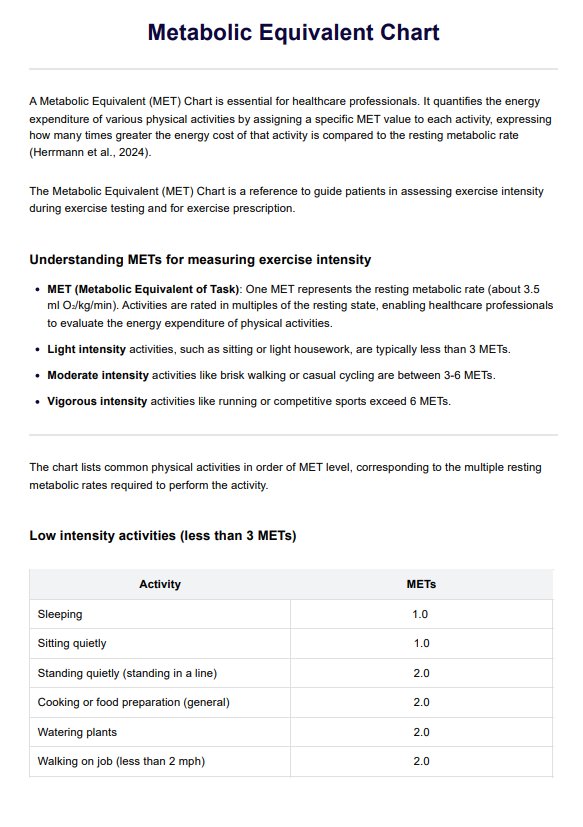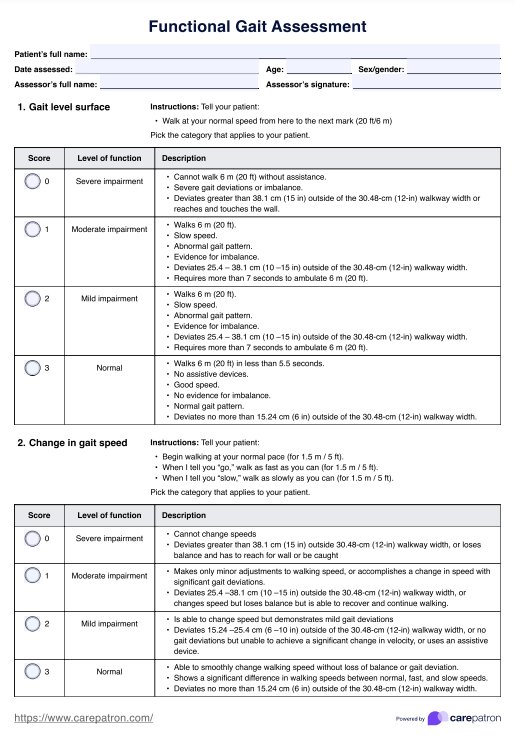Metabolic Equivalent
Access our Metabolic Equivalent Chart, a valuable reference tool in determining energy expenditure in your patient's physical activities.


What is a Metabolic Equivalent Chart?
A Metabolic Equivalent (MET) Chart is an essential tool for healthcare professionals. It quantifies the energy expenditure of various physical activities by assigning a specific MET value to each activity, expressing how many times greater the energy cost of that activity is compared to the resting metabolic rate (Herrmann et al., 2024).
One MET equals the oxygen consumption at rest, typically about 3.5 ml O₂/kg/min. The Compendium of Physical Activities categorizes activities from light (e.g., sitting) to vigorous (e.g., running), enabling precise exercise prescription based on individual functional capacity.
MET values assess a patient's fitness level in exercise testing and prescribe appropriate exercises. For example, moderate-intensity activities such as brisk walking have a MET value of around 3-6. This system allows clinicians to tailor exercise programs based on the patient’s body weight, functional capacity, and goals, ensuring safe and effective interventions.
By referencing this tool and the guidelines on physical activity by agencies such as the World Health Organization and the US Department of Health and Human Services, healthcare providers can guide patients toward activities that improve health outcomes without exceeding safe energy expenditure levels. The MET chart thus supports both fitness development and rehabilitation strategies.
Metabolic Equivalent Template
Metabolic Equivalent Example
How does it work?
The Metabolic Equivalent Chart is a vital resource for healthcare professionals, enabling them to quantify and assess the energy cost of various physical activities. The chart lists different activities alongside their corresponding MET levels, which represent multiples of the resting metabolic rate. Here are the steps for using this chart:
Step 1: Access the chart
To begin, access the chart for met levels by clicking the "Use Template" button in the guide available on Carepatron.
Step 2: Understand energy cost
Familiarize yourself with how MET levels represent the energy cost of various activities. A 1 MET activity equates to resting, while higher MET levels indicate more intensive activities.
Step 3: Review exercise intensity
Use the chart to distinguish between activities of light, moderate, and vigorous intensity. For instance, moderate exercise ranges from 3 to 6 METs, like bicycling for leisure or hot yoga.
Step 4: Evaluate lean body mass and body fat impact
Consider the patient's lean body mass and body fat when prescribing exercises, as these influence the metabolic rate and energy expense.
Step 5: Implement the plan
Use the MET levels as a reference to guide your patients, suggesting exercises that align with their goals and physical capacity.
When would you use this chart?
The MET chart is an essential tool in healthcare for assessing and guiding patients' physical activity levels. It offers a standardized way to quantify caloric consumption and the energy expenditure of various activities and helps clinicians tailor exercise prescriptions based on a patient’s specific needs.
By referencing METS in exercise testing, healthcare professionals can accurately gauge a patient’s functional capacity and provide interventions to improve cardiorespiratory fitness. This tool ensures that the intensity and type of activity match the individual's physical state.
Evaluation of functional capacity
This chart helps evaluate functional capacity, especially when determining how a patient performs under exertion. It allows clinicians to estimate how many patients can safely handle METS, especially after cardiac events or surgeries. Based on the METs, clinicians can prescribe safe physical activity guidelines.
Exercise prescription and evaluation
The chart is critical for developing and assessing exercise prescriptions. It ensures patients engage in appropriate activities for their fitness level and helps match activities to the patient’s cardiorespiratory fitness goals.
Caloric consumption estimation
It helps estimate how many calories are burned during different activities. This can be useful in managing weight loss programs or caloric consumption for patients with metabolic disorders.
Human services programs
For patients in human services programs like rehabilitation, the MET chart offers a framework for monitoring health benefits derived from engaging in activities requiring twice the energy of their resting state.
Sports and human kinetics applications
Incorporated into human kinetics programs, the MET chart can ensure that patients exercise at a light effort or a more vigorous pace, depending on their ability.
Research and evidence
The MET chart is an indispensable tool in clinical and research settings. It serves as a benchmark for quantifying energy expenditure and guiding exercise prescription.
Research has demonstrated the practical applications of the MET Levels Chart in exercise physiology and sports medicine. The study of Jetté et al. (1990) highlights how MET values can be used to evaluate a patient's functional capacity and how METs help define the oxygen uptake required for specific activities. This allows clinicians to ensure that exercise prescriptions meet patient needs without exceeding their physical limits.
Moreover, the 2024 Adult Compendium of Physical Activities updates the MET values for various activities, enhancing their precision. They emphasize the importance of accurately assessing how much oxygen is needed for a particular activity to ensure appropriate energy expenditure (Herrmann et al., 2024). This refinement is particularly important in fields such as sports medicine, where it is essential to measure the energy expended during exercise and adjust physical activity recommendations accordingly.
The MET chart is vital for evaluating oxygen uptake, energy costs, and functional capacity, making it an invaluable tool for healthcare providers. It supports both exercise prescription and rehabilitation, ensuring that patients and athletes alike receive guidance tailored to their fitness levels and medical conditions, leading to better overall health and performance outcomes.
References
Herrmann, S. D., Willis, E. A., Ainsworth, B. E., Barreira, T. V., Hastert, M., Kracht, C. L., Schuna, J. M., Cai, Z., Quan, M., Tudor-Locke, C., Whitt-Glover, M. C., & Jacobs, D. R. (2024). 2024 Adult Compendium of Physical Activities: A third update of the energy costs of human activities. Journal of Sport and Health Science, 13(1), 6–12. https://doi.org/10.1016/j.jshs.2023.10.010
Jetté, M., Sidney, K., & Blümchen, G. (1990). Metabolic equivalents (METS) in exercise testing, exercise prescription, and evaluation of functional capacity. Clinical Cardiology, 13(8), 555–565. https://doi.org/10.1002/clc.4960130809
Commonly asked questions
MET values help healthcare providers create tailored exercise prescriptions by specifying the intensity of activities that patients can safely perform. For example, a light-intensity activity might range from 1-3 METs, moderate intensity from 3-6 METs, and vigorous intensity from 6 or more METs. By referencing a patient’s MET capacity, clinicians can safely guide them through exercises that will improve their cardiorespiratory fitness without overexertion.
Yes, MET values can vary depending on factors such as body weight, muscle mass, age, and fitness level. For instance, individuals with higher muscle mass may expend more energy during the same activity than someone with less. Likewise, environmental conditions like temperature and terrain can affect the MET value of activities.
The MET chart helps estimate how many calories are burned during physical activities. Since 1 MET corresponds to an energy expenditure of approximately 1 kcal per kilogram of body weight per hour, healthcare professionals can use MET values to calculate caloric consumption for various activities. For example, a 70 kg person performing a 5 MET activity for 1 hour would burn roughly 350 calories.












































































































